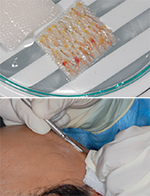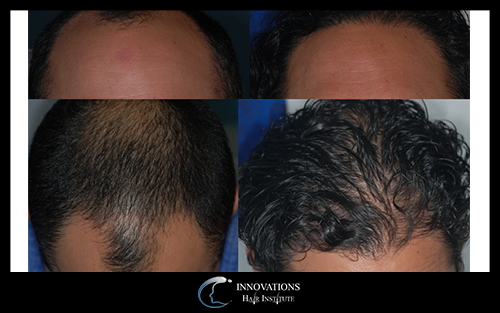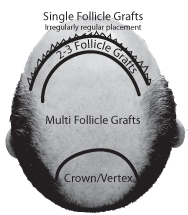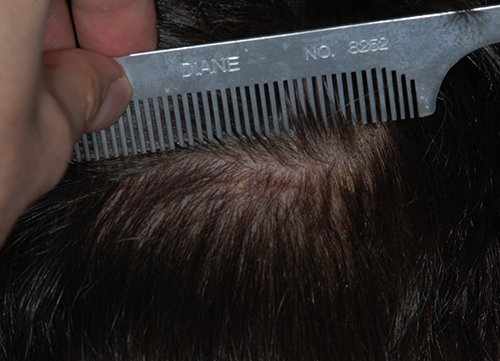Follicular Unit Transplant
Gold standard in hair restoration surgery
What is a follicular unit transplant (FUT)?

A follicular unit transplant (FUT) is a hair restoration procedure that uses follicular unit grafting to place hairs. Follicular unit grafting (FUG) is the gold standard in hair transplant surgery. Follicular unit grafting involves harvesting hair from areas that are not susceptible to adrogenic alopecia, dissecting out individual or small groups of hair follicles (photo at left, top), making holes in the scalp using a special knife (photo at left, bottom), and placing the hairs back into the scalp. Follicular unit grafting grew out of hair plug surgery. Hair plugs transferred 20-25 hairs at a time. Follicular unit grafting will transfer 1-5 hair follicles at a time. Using follicular unit grafting, hair restoration surgeon Dr. D.J. Verret can create natural appearing hairlines with lasting results.

Hairline Design
Hairline design is critical to a natural hairline. Transplanted hair must not only approximate the outline of the natural hairline, but it must also approximate the angle of the natural hair. When making the recipient sites, Dr. Verret takes special care to note the angle of the hair with the scalp and direction of the natural hair and how it changes over portions of the scalp. For instance, at the front of the scalp, hair is angled forward, while in the temple and sideburns it is angled down.
The number of follicles per graft is also important to maintain a naturally appearing hairline. Individual follicles placed in random patterns are used to define the edge of the hairline. Slightly back from the edge, 2-3 follicle grafts are used for added coverage. Beyond this, 1-5 follicle grafts may be safely used to increase hair density and cover a balding area.

Crown Restoration
Recreation of a bald crown of the head is a bit more challenging. The crown of the head has significant variation in the angle of the hair. Dr. Verret uses special care to varying the angulation of this area when recreating the hairline to keep a natural appearance. Most grafts placed in this area are single or at most 2-3 follicle grafts.
For adding density at the top of the head, small squares are created to ensure even distribution of the transplanted hairs. The size and density of each square will depend on a patient’s remaining hair density, the number of grafts to be transplanted in the current session, and the size of the area of concern. For a hair transplant hairline to look natural, these subdivisions will often encompass a small strip along the hairline to ensure adequate density.
Strip harvest scar at one month

Donor Site Harvest
There are two ways to harvest hair to place for follicular unit grafting: follicular unit extraction and strip harvesting. Strip harvesting involves removing a strip of hair from the sides and back of the scalp. The strip of hair is then dissected into individual grafts. A graft may have 1-5 hair follicles (individual hairs). The hairs is then placed back into the recipient sites. With strip harvesting, the hair does not have to be shaved for harvest. The strip does create a linear scar but this usually heals quite well. As a facial plastic surgeon trained in hair restoration, Dr. Verret has patients who can still use a #2 clipper without showing a scar. The photo on the left shows a strip harvest scar one month after surgery.
Follicular unit extraction on the other hand involves using a device to individually remove hairs. The donor area has to be shaved and will take several weeks to grow back. Once healed, small white dots will appear where the hair is harvested. With either method, if the hair is completely shaved, some type of scar is visible.
All photos are models unless otherwise noted. (c) 2017. All rights reserved.

